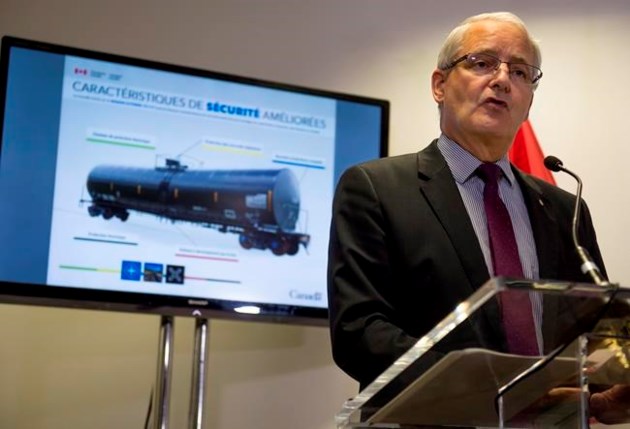Repost from CBC News
3 former MMA rail workers acquitted in Lac-Mégantic disaster trial
Locomotive engineer and 2 others found not guilty of criminal negligence causing 47 deaths
Alison Brunette · CBC News · 19 January 2018
Jurors have acquitted the three former Montreal, Maine and Atlantic (MMA) railway employees charged with criminal negligence causing death in the 2013 Lac-Mégantic rail disaster.
Locomotive engineer Tom Harding, 56, rail traffic controller Richard Labrie, 59, and operations manager Jean Demaître, 53, were all charged after the derailment of a runaway fuel train early on July 6, 2013. Several tankers, carrying highly volatile crude oil exploded, turning downtown Lac-Mégantic into an inferno and killing 47 people.
There was an audible gasp in the courtroom when the verdict was delivered early Friday afternoon.
Labrie couldn’t hold back tears as he described his relief. He said that his thoughts are with the community of Lac-Mégantic.
“I would like to say the people of Lac-Mégantic, what they went through, they showed a huge amount of courage,” he said.
“I wasn’t intending to cry. But I can tell you it was difficult — it was a long process.”
The eight men and four women on the jury have been deliberating since Thursday morning, Jan. 11, at the Sherbrooke, Que., courthouse, after a marathon trial which began last September.
The jurors have endured countless hours of technical testimony from train experts, heard dramatic audio recordings of emergency workers and railway employees from the night of the explosions, and listened to other former MMA employees called as Crown witnesses describe a work environment with little regard for safety standards and no budget for training.
Quebec Superior Court Justice Gaétan Dumas thanked the jury members for their work, telling them that the case wasn’t easy.
“You are the most enthusiastic jury I have ever seen,” he said.

Last, ill-fated journey
Harding, who pitched in on the night of the disaster, helping emergency responders detach the fuel cars that hadn’t exploded, was the driver of the ill-fated fuel train.
He picked up the 73-tanker car train in Farnham, Que., 60 kilometres southeast of Montreal, on the afternoon of July 5, 2013.
Late that evening, he left the train idling on the tracks in the village of Nantes, 13 kilometres west of Lac-Mégantic, where it was to be picked up by an American crew the following day.
During the three-month trial, the court heard how a fire broke out in the smokestack of that locomotive shortly after Harding left it unattended.
Firefighters arrived and extinguished the fire, shutting down the locomotive’s engine and breakers, which disabled the air brakes that were securing the train. Jurors heard that less than an hour later, the runaway train barrelled down the tracks, derailing in downtown Lac-Mégantic. The resulting explosions engulfed the town in flames.
Several of the Crown’s 31 witnesses described Harding as an experienced, knowledgeable and helpful co-worker, which the Crown alluded to in closing arguments.
“Despite all comments on Harding, on July 5, he failed to do his job,” prosecutor Sacha Blais told the jury.
“A careful engineer would have foreseen the danger.”
Much of the Crown’s testimony revolved around the seven handbrakes Harding applied to the train, whether the engineer tested them and how many would have been sufficient to secure the train properly.
In closing arguments, Harding’s lawyer, Charles Shearson, countered that the engineer followed the MMA’s general operating instructions.
Shearson listed a number of other factors that contributed to the derailment, including the safety of one-man crews and MMA’s failure to conduct a risk assessment on the consequences of parking a heavy fuel train on a slope at Nantes. The Transportation Safety Board’s report identified the rail line between Nantes and Lac-Mégantic as the second steepest grade of any stretch of track in Canada.
Accused waived right to mount defence
Harding, as well as the other two accused, waived their right to mount a formal defence to the charges.
Labrie, the rail traffic controller on duty that night, was on shift 200 kilometres away in Farnham, relying on information being provided to him by telephone, his lawyer, Guy Poupart, reminded the jury in closing arguments.
Poupart said the Crown failed to “demonstrate in any way that a rail traffic controller placed in the same position as Labrie and given the same information, would have acted any differently.”
Demaître, MMA’s senior manager in Quebec, was at home near Saint-Jean-sur-Richelieu and on call on the night of the disaster. The Crown argued he had been negligent, ignoring complaints about the lead locomotive’s mechanical defects.
“A supervisor should have ensured all safety,” Blais concluded.
Demaitre’s lawyer, Gaétan Bourassa, urged the jurors to distinguish between his client’s actions and those of his former employer.
“This is the trial of Jean Demaître, not the trial of MMA through Jean Demaître,” Bourassa said in his closing arguments.
“There is a tremendous difference.




